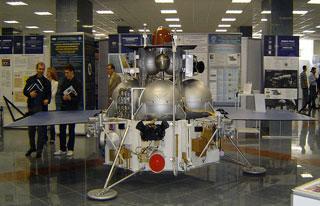
A full-scale mockup of Russia's Phobos-Grunt sample return spacecraft to Mars' moon Phobos. Photo: CNES.
PARIS (AFP): Engineers fought desperately to save Russia's Phobos-Grunt spacecraft after the Martian probe sent "a first sign of life" more than two weeks after being stranded in orbit.
After days of frustrating silence, contact with the probe was made on Tuesday at 2025 GMT at a European Space Agency ground station in Perth, Western Australia, the Paris-based ESA said.
"ESA teams are working closely with engineers in Russia to determine how best to maintain communication with the spacecraft," it said.
A spokesman at European Space Operations Centre (ESOC) in Darmstadt, Germany, told AFP: "We sent an instruction to (the probe) to switch on its transmitter and the probe sent us telemetric data.
"However, we do not have all the details and we are not very sure of what we received. It's a first sign of life," he said.
The probe is in a "very low, very unfavourable orbit (that) is difficult to identify accurately," the spokesman added.
The task is being complicated by very narrow windows for communication "of between five and 10 minutes," he explained.
The five-billion-ruble (USD 165-million) mission is one of the most ambitious in the history of Martian exploration.
It is designed to travel to the moon of Phobos, scoop up soil and return the sample to Earth by 2014.
But mission control lost radio contact with the craft hours after launch on November 8, leaving engineers bewildered as to where it was. On Tuesday, Russia's space agency had said it saw "little chance" of saving the 13.5-tonne vessel.
In Moscow, the Russian space agency Roscosmos confirmed the ESA report.
It said the Perth station had received a radio signal from Phobos-Grunt during a scheduled monitoring period and European and Russian were "appraising the situation."
The probe blasted off successfully from the Baikonur cosmodrome but did not manage to leave its Earth orbit as planned.
Motors failed to fire twice to steer it on a course for Mars, and it is still carrying the fuel that would have been used in this manoeuvre.
But before losing control of the probe, the Russians sent out instructions for it to deploy its solar panels, an ESA official said.
"Initially, it was thought that the spacecraft would die after three days when its battery ran out.
"But the solar panels played a crucial role yesterday, enabling the ground station in Perth to make contact," the source said.
Perth is the sole means of communicating with Phobos-Grunt as it is the only listening post in a part of the Earth that is in daylight when the probe passes overhead, the official explained.
 Previous Article
Previous Article Next Article
Next Article











The Indian Air Force, in its flight trials evaluation report submitted before the Defence Ministry l..
view articleAn insight into the Medium Multi-Role Combat Aircraft competition...
view articleSky enthusiasts can now spot the International Space Station (ISS) commanded by Indian-American astr..
view article